Share

The Regenerative Agroforestry Podcast
#12 Grazing cattle in the woods with Brett Chedzoy
In this episode, Brett Chedzoy shares with us his extensive experience practicing and teaching silvopasture. Brett clearly discussed some of the key issues, challenges and opportunities associated with silvopasture. We spent quite some time covering the importance of rotational grazing and how silvopasture differs from pasture grazing. We cover specific topics such as tree fodder, animal behaviour and the different interactions between trees and animals. We finish the conversation with a practical step by step method to convert a forest into a silvopasture system.
TABLE OF CONTENTS
00:02:00 Introduction
00:06:58 Silvopasture basics
00:13:40 Challenges and risks
00:17:26 Grazing on pasture vs rotational grazing in silvopasture
00:34:08 Effect of animal presence on tree growth
00:39:16 Animal behaviour
00:43:25 Tree fodder and browsing
00:47:45 Forage quality
00:56:29 Skills necessary to transition to silvopasture grazing
01:00:38 Stocking density and rotation timing
01:06:30 Three step process to convert forest to silvopasture
01:16:23 Resources
• RESOURCES
https://silvopasture.ning.com/
https://sites.google.com/site/theangusglenfarm/home
• GET IN TOUCH www.regenerativeagroforestry.org
• SUPPORT US www.gumroad.com/regenagroforestry
More episodes
View all episodes
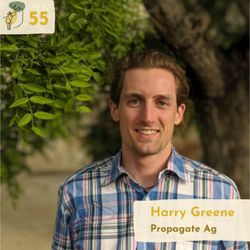
55. #55 Economic modelling and agroforestry design with Harry Greene
01:18:05||Ep. 55Propagate is a leader in the agroforestry space, specialising in project development and planting agroforestry systems at scale. It's a huge pleasure to chat with Harry, co-founder and Chief Research Officer of the US-based company. Tune in as we geek out on agroforestry economics, economic modelling, design implications and financing options. We delve into questions such as: How do you business plan agroforestry systems? How do we find a balance between economic performance and ecosystem services? And much more!• RESOURCEShttps://www.propagateag.com/• GET IN TOUCH www.regenerativeagroforestry.org• SUPPORT US www.gumroad.com/regenagroforestry• FOLLOW US on Twitter, Facebook, LinkedIn and Instagram• FUNDING FOR EUROPEAN PROJECTS https://explore.ecosia.org/regenerative-agriculture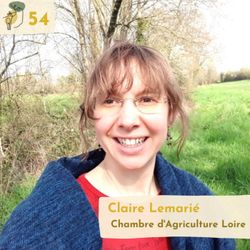
54. #54 The importance of peer to peer learning to activate local agroforestry dynamics with Claire Lemarié
58:35||Ep. 54In this episode I discuss with Claire Lemarié her experience working with farmers in the Pays de la Loire region in France, where she is a technical adviser for the chamber of agriculture. She has precious insights into the management of mature hedges, as this region still has a significant amount of bocage: a traditional french hedge layout. In this interview we gain an understanding of why effective information sharing between farmers is crucial to creating innovative agroforestry systems and how she enables peer to peer exchange through the 'Club des Agroforestiers'.• RESOURCEShttps://www.linkedin.com/in/claire-lemari%C3%A9-34b667155/?originalSubdomain=frYoutube video Chambre d'agriculture de la Loire• GET IN TOUCH www.regenerativeagroforestry.org• SUPPORT US www.gumroad.com/regenagroforestry• FOLLOW US on Twitter, Facebook, LinkedIn and Instagram• FUNDING FOR EUROPEAN PROJECTS https://explore.ecosia.org/regenerative-agriculture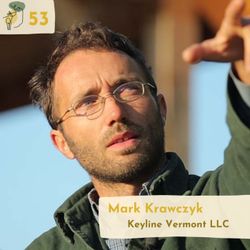
53. #53 Practicalities of integrating coppicing into your farm with Mark Krawczyk
01:40:18||Ep. 53Coppicing is an ancient and modern tree management system. Coppicing is known for its multi-functionality: capable of producing biomass, animal forage, firewood and much more. Today we interview Mark Krawczyk, practitioner, consultant and author of 'Coppice Agroforestry'. In this interview we tackle some of the practical challenges of coppicing, to better understand the economic potential of this technique. Mark demonstrates a variety of nuances and compromises, showing us the versatility as well as the key challenges of this technique. TABLE OF CONTENTS00:02:22 Introduction00:13:19 What are the key concepts of coppicing00:27:50 What impact on tree health? 00:39:12 What prospects for mechanising management? 00:51:44 What uses for coppiced wood? 01:17:42 What effect of coppicing on surrounding plants? 01:22:24 Productivity of coppice stands01:29:14 In relation to soil types• RESOURCEShttps://www.keylinevermont.com/http://www.coppiceagroforestry.com/https://regenerativeskills.com/mark-krawczyk-on-coppice-agroforestry-and-woodland-management-part-1/• GET IN TOUCH www.regenerativeagroforestry.org• SUPPORT US www.gumroad.com/regenagroforestry• FOLLOW US on Twitter, Facebook, LinkedIn and Instagram• FUNDING FOR EUROPEAN PROJECTS https://explore.ecosia.org/regenerative-agriculture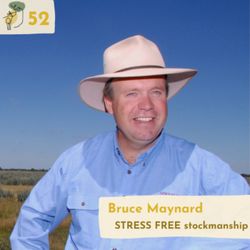
52. #52 Agroforestry at the landscape scale to transform ecological function and boost productivity with Bruce Maynard
01:22:00||Ep. 52Bruce Maynard and his family are livestock managers and row crop farmers in New South Wales in Austalia. Over his carreer, he has succesfully integrated shrubs and trees to their livestock and row crop operation. He has been able to double his stocking rate through increasing the ecological function of the farm. We dig deep into the design of his tree systems and how it has evloved over the years. We unpack in detail how he has been able to transform his landscape on such a large scale and how this was possible from a business perspective. TABLE OF CONTENTS00:01:21 Bruce's story and description of the farm00:10:06 No-kill cropping00:15:05 Complexifying the landscape00:22:57 Design over time00:30:19 Taking machinery into account00:37:57 Specifics of saltbush00:42:30 Recovery times between bush and pasture00:54:06 Microclimatic benefits00:57:30 Planting trees at scale and its logistics01:10:30 Management of trees/shrubs01:16:00 Business strategy and cashflow01:19:32 Ressources to go further• RESOURCEShttp://selfherding.com/index.htmlhttps://stressfreestockmanship.com.au/https://www.youtube.com/watch?v=fHzo0fDBZs0• GET IN TOUCH www.regenerativeagroforestry.org• SUPPORT US www.gumroad.com/regenagroforestry• FOLLOW US on Twitter, Facebook, LinkedIn and Instagram• FUNDING FOR EUROPEAN PROJECTS https://explore.ecosia.org/regenerative-agriculture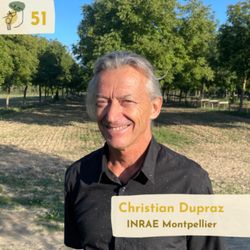
51. #51 Feedback from 30 years of research on alley cropping systems with Christian Dupraz
01:05:34||Ep. 51What have we learnt from 30 years at one of the most prominent agroforestry research sites in the world? In collaboration with AGROMIX, We are excited to present an interview with Christian Dupraz, a leading agroforestry researcher from INRAE Montpellier. This is one of our rare 'in person' interviews where we discussed years of findings under the alley cropping walnut trees of the Domaine de Restinclières. We analysed many technical details such as tree - crop competition, tree pruning and adapted tree species. We also discussed socio-economic aspects such as the relationship with the local farmers and the reason why alley cropping systems have not yet been scaled. Enjoy!TABLE OF CONTENTS02:25 Introduction11:12 Experiment today13:38 Growth rate of trees17:43 Impact of AF on the quality of the wood20:13 Considerations to produce a straight trunk00:22 Impact on arable crop 00:26:45 Competition between crop and tree00:30:18 Effect of pollarding on tree quality00:33:56 How do the trees effect the row crop farmer? 00:38:08 How would tree crops fare in alley cropping? 00:39:32 Increase in bat population and its benefits00:44:36 Main mistakes 00:48:05 What context for alley cropping to be successful? 00:56:30 Why do we not see more alley cropping?• RESOURCEShttps://www.researchgate.net/profile/Christian-Dupraz-3https://agromixproject.eu/• GET IN TOUCH www.regenerativeagroforestry.org• SUPPORT US www.gumroad.com/regenagroforestry• FOLLOW US on Twitter, Facebook, LinkedIn and Instagram• FUNDING FOR EUROPEAN PROJECTS https://explore.ecosia.org/regenerative-agriculture• FIND OUT MORE ABOUT OUR COLLABORATION WITH AGROMIX HERE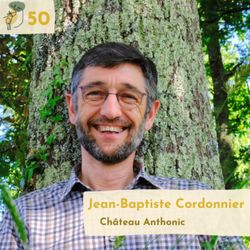
50. #50 Hedges and trees as pillars of a viticulture agroecology transition with Jean-Baptiste Cordonnier
01:38:56||Ep. 50Conventional viticulture and its intensive management has created some important challenges for wine producers and the regions where they are located. Jean-Baptiste Cordonnier has been able to intimately experience the conventional approach, seeing the fertility and biodiversity of his family's château gradually degrade. For the first time since the start of the show, we are able to delve into the story of an incredible viticulture agroforestry transition. With cover crops, hedges and alley cropping, Jean-Baptiste is innovating new solutions for a management intensive crop. We delve into the story, context, agronomy and practical details of his strategy, for an interview rich in experiences and lessons learnt. TABLE OF CONTENTS00:02:55 Introduction00:07:53 Trial and error to find regenerative solutions00:13:39 Effects of planting hedges on the vineyard00:23:08 Design process00:36:58 Managing weeds and pruning hedges00:43:33 Managing the pruning at scale00:48:12 Mulching and the importance of cover crops01:04:02 Trees planted within the vineyard01:10:35 What are the expected agronomic results? 01:16:49 Why advantages outweigh challenges 01:21:23 Looking at the economics01:31:16 Are neighbouring vineyards interested?01:34:20 What effect do you expect on the quality of wine?• RESOURCEShttps://chateauanthonic.com/en/https://www.instagram.com/chateau_anthonic/https://www.facebook.com/chateauanthonic/• GET IN TOUCH www.regenerativeagroforestry.org• SUPPORT US www.gumroad.com/regenagroforestry• FOLLOW US on Twitter, Facebook, LinkedIn and Instagram• FUNDING FOR EUROPEAN PROJECTS https://explore.ecosia.org/regenerative-agriculture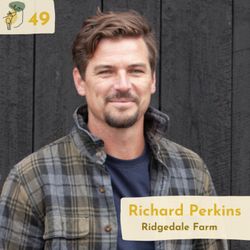
49. #49 The potential of agroforestry in human scale regenerative enterprises with Richard Perkins
01:01:21||Ep. 49I am today with Richard Perkins from Ridgedale Farm in Sweden. For those who do not know, Richard is a leading educator and author in the field of regenerative agriculture, specialising in human scale enterprises. We discuss the tree systems he has planted on his farm, and more specifically the opportunity of integrating trees to market gardening and pastured poultry, two of his key enterprises. Richard is also an educator with the mission of helping farmers to build and manage successful small scale farms. He is therefore the ideal guest to have a conversation on how to make small scale agroforestry systems viable, and their place in the farm strategy.TABLE OF CONTENTS01:41Richard’s story05:45 What perennial systems on the farm? 16:08 What place for perennial crops in your long term strategy? 21:30 How do you manage your skill set? 26:07 What oportunity for low managment tree plantings? 31:00 How do you balance complexifying your ecology and maintaining efficiency? 35:48 How to intergrate trees in your market garden? 37:35 Trees and pastured poultry 41:06 How do you make agroforestry profitable on a small scale? 44:32 Funding tree plantations48:41 Where should we prioritise planting trees in the landscape? • RESOURCEShttps://www.richardperkins.co/https://www.youtube.com/c/RichardPerkinsofRidgedale/• GET IN TOUCH www.regenerativeagroforestry.org• SUPPORT US www.gumroad.com/regenagroforestry• FOLLOW US on Twitter, Facebook, LinkedIn and Instagram• FUNDING FOR EUROPEAN PROJECTS https://explore.ecosia.org/regenerative-agriculture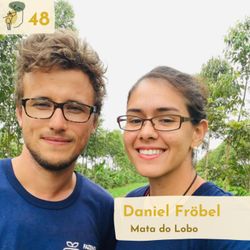
48. #48 Striking the balance between complexity and efficiency in large scale Syntropic systems with Daniel Fröbel
01:35:09||Ep. 48Today we continue investigating Syntropic Farming with Daniel from the Mata do Lobo farm in Brasil. In the past 4 years, they have been working solutions to scale these complex agroforestry systems, soon reaching 50ha planted. Daniel and his partner, Maria Vittoria, have accumulated some tremendous experience as they build one of the most innovative coffee plantations out there. In this episode, you will find out what is the difference between the health and quality of agroforestry coffee and conventional coffee. You will also understand how they are striking a balance between efficiency and complexity - in order to integrate the principles of Syntropic whilst managing these systems at scale. This was a highly practical conversation, inspired by the questions we received from our listeners on social media. We hope you enjoy! TABLE OF CONTENTS03:47 Daniel’s story12:35 Objective of the agroforestry plot 16:01 How do you manage inputs? 20:02 What makes Syntropic less input intensive? 22:39 What does the agroforestry produce? 31:09 How much diversity is integrated to the coffee crop? 35:51 How is the coffee crop responding to the Syntropic system? 41:46 How are coffee yields expected to perform in comparison to conventional? 45:41 How did he plant so many trees effectively? 51:01 How many people working on the agroforestry system? 55:23 How do you manage so much biomass? 01:07:26 What harvesting process for coffee? 01:12:16 What potential of mechanisation for Syntropic systems? 01:14:57 What commercialisation strategy? 01:19:44 Is he planning a processing facility? 01:21:48 Could Syntropic systems work in a European context? 01:24:08 Where does he get knowledge from? • RESOURCEShttps://www.instagram.com/matadolobo/?hl=en• GET IN TOUCH www.regenerativeagroforestry.org• SUPPORT US www.gumroad.com/regenagroforestry• FOLLOW US on Twitter, Facebook, LinkedIn and Instagram• FUNDING FOR EUROPEAN PROJECTS https://explore.ecosia.org/regenerative-agriculture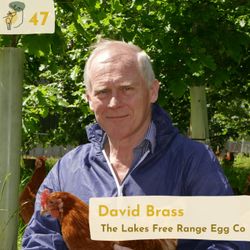
47. #47 The synergies of trees and poultry and adopting silvo-poultry at scale with David Brass
56:35||Ep. 47David Brass is the CEO of the Lakes Free range egg company. Almost 30 years ago he started planting trees in the fields to encourage his laying hens to go and range. Since then, he has been busy planting trees throughout his supply chain. With about 70 farmers and 2 million birds supplying eggs to his company today, this is an example of agroforestry working at scale. The interview brings forward both practical considerations for the layout and maintenance of trees, and explains how they have managed to onboard their suppliers. David is enthusiastic about the numerous benefits trees have bought, carefully documented with various studies. He is convincd that there is a very clear case for integrating trees in all poultry production with very limited trade-offs. TABLE OF CONTENTS02:05 Story and overview of the company 04:08 Bringing trees onto the farm 10:14 Current design12:16 Potential to add a perennial production? 16:51 Is it realistic to incorporate trees as part of the feed? 18:06 What does it mean practically for a poultry farmer to intergrate trees? 22:35 How are the tree plantations evolving? 27:12 Scaling tree plantations within their suppliers 30:58 Funding 34:34 Trees and animal welfare 37:00 Impact of tree planting on profitability. 39:49 Initial reluctance of some farmers 42:34 Is the agroforestry approach something that is valued by your customers? 44:18 the numerous benefits of planting trees46:15 Do you see payment for ecosystem services as part of your model. 50:21 Supply chain requirements are driving change 54:52 Impact of tree planting on biodiversity • RESOURCEShttps://lakesfreerange.co.uk/https://www.facebook.com/lakesfreerange/https://www.farmtreestoair.ceh.ac.uk/ART• GET IN TOUCH www.regenerativeagroforestry.org• SUPPORT US www.gumroad.com/regenagroforestry• FOLLOW US on Twitter, Facebook, LinkedIn and Instagram• FUNDING FOR EUROPEAN PROJECTS https://explore.ecosia.org/regenerative-agriculture